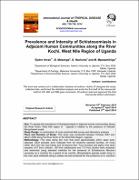| dc.contributor.author | Ejotre, Imran | |
| dc.contributor.author | Makanga, B | |
| dc.contributor.author | Nachuha, Sarah | |
| dc.contributor.author | Mpezamihigo, Mouhamed | |
| dc.date.accessioned | 2017-05-04T06:25:31Z | |
| dc.date.available | 2017-05-04T06:25:31Z | |
| dc.date.issued | 2014 | |
| dc.identifier.citation | Ejotre, I et al ... (2014) Prevalence and Intensity of Schistosomiasis in Adjacent Human Communities along the River Kochi, West Nile Region of Uganda. International Journal of tropical Disease & Health. Vol.4(6) pp.29-739 | en_US |
| dc.identifier.uri | http://hdl.handle.net/20.500.12309/132 | |
| dc.description.abstract | Aim: To assess the prevalence of Schistosomiasis in adjacent human communities along
the River Kochi, West Nile region of Uganda in relation to the presence of infected
Biomphalaria snails
Study Design: A combination of cross sectional field survey and laboratory analysis
Place and Duration of Study: This study was conducted between October 2007 and
March 2008 along the River Kochi in the West Nile Region, Uganda.
Methodology: Five sites along this river that were approximately 20km apart were
selected. Stool samples were collected from 40 randomly selected families, 20 living
within 3km from the river banks and 20 beyond 3km. Four hundred and eighty nine stool
samples (157 from children, 159 from adolescents and 173 from adults) were analysed
and examined using standard methods for the presence of Schistosoma Mansoni
cercariae on a monthly for a period of six months. Biomphalaria species snails living in
the river were collected using a sweep net and screened for the presence of S. mansoni cercariae. A generalised Linear Model was used to establish associations between
human parasitic infections with age and gender. Spearman’s rank correlations coefficient
was used to explore the relationship between infected Biomphalaria snail numbers and
infection incidence in humans.
Results: Percentage infection of 24.1% (118/459) was recorded. Prevalence of
Schistosomiasis was lower in children than in adolescents (P=.001) and adults (P=.013),
and was overall slightly higher in males than females (P=.014). A Spearman’s rank
correlations coefficient of (rs=.710) revealed that there was a link between infected
Biomphalaria snail numbers and infection incidence in humans.
Conclusion: From the results it appears that Schistosomiasis is still present in West Nile
region and is associated with the presence of infected Biomphalaria snail species. Male
adolescents and adults are more prone to infection than the females. There is need for
regular surveys and continuous Schistosomiasis education to the communities. | en_US |
| dc.language.iso | en | en_US |
| dc.publisher | International Journal of tropical Disease & Health | en_US |
| dc.subject | Schistosomiasis | en_US |
| dc.subject | Cercariae | en_US |
| dc.subject | Biomphalaria | en_US |
| dc.subject | River kochi | en_US |
| dc.subject | West nile | en_US |
| dc.subject | Uganda | en_US |
| dc.subject | Human Communities | en_US |
| dc.title | Prevalence and Intensity of Schistosomiasis in Adjacent Human Communities along the River Kochi, West Nile Region of Uganda | en_US |
| dc.type | Article | en_US |

